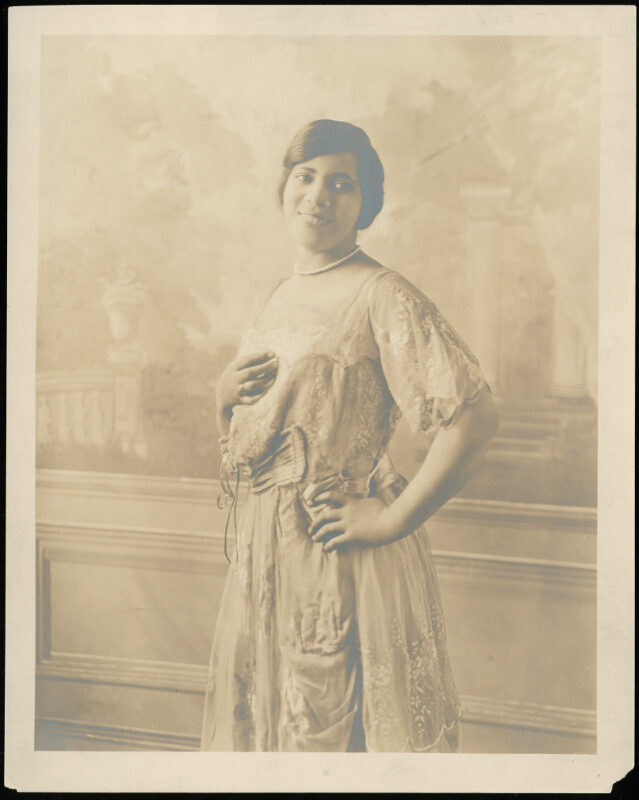Singing Like Germans: Black Musicians in the Land of Bach, Beethoven, and Brahms

In honor of Black History Month, we delve into Singing Like Germans: Black Musicians in the Land of Bach, Beethoven, and Brahms by Kira Thurman. The book recounts the rich history of Black classical musicians training and performing in Austro-Germany from the 1870s to the 1960s. Thurman argues that the presence of Black musicians in Germany simultaneously challenged and bolstered the concept of the universality of German art music—and, therefore, what it meant to be German—at a pivotal time when national borders were being drawn and redrawn. The eye-opening book sheds light on the lives and careers of individual artists and their place within broader historical events, offering unique insight into both American and European history and the intersection of racism, nationalism, and the arts.
This book is also unique in its focus on Black classical musicians specifically. Most scholarship to this point has upheld a narrow conception of what constitutes “Black” musical aesthetics by focusing solely on jazz, hip-hop, and gospel. Of course, these investigations are valuable and necessary, but limiting the narrative to these genres perpetuates the erasure of Black classical musicians from classical music history, Thurman argues. “There must be space in scholarship for Black cultural activity and agency that both expands and calls into question what we have come to define as Black aesthetics,” she writes in her introduction. “Discussing these activities does not diminish or jeopardize the work of racial justice. Instead, it bolsters us to consider new definitions of Blackness and music in ever-shifting global contexts.”
Dr. Thurman is Associate Professor of History, German Studies, and Musicology at the University of Michigan. She is also a classically trained pianist who grew up in Vienna, Austria. Her passion for and connection with the material is evident. Since publication by Cornell University Press in 2021, Singing Like Germans: Black Musicians in the Land of Bach, Beethoven, and Brahms has won numerous awards and praise from critics. NPR named it one of the Best Books of 2021, and Alex Ross from The New Yorker praised it as “one of the most original and revelatory books to have been written about classical-music history in many years.”
While Singing Like Germans is essentially an academic book with sixty pages of endnotes and bibliography, Thurman’s writing is so direct and engaging that it will have wide appeal to anyone interested in classical music, Black history, and/or modern European history. Thurman’s book comes at a crucial time when music institutions are reevaluating the whiteness of the classical music canon and its Germanic framework. Those of us who attended music school or took a music appreciation course were likely taught “the three Bs”: Bach, Beethoven, and Brahms. The field of musicology, having grown out of Austro-Germany, is naturally predisposed to favor German composers, styles, and genres over others. For instance, the German symphony was long thought to be a more “serious” and “pure” art form than French or Italian opera.
The notion of the superiority and universality of German art music has been pivotal to German identity since the eighteenth century. Thurman explains, “By proposing that universal music was serious, pure, and soulful and by positioning German music as the only true expression of these universal values, German aesthetes, nationalists, and even politicians transformed a universalist message into a nationalist idea. Simultaneously belonging to all and also authentically German, the Austro-German musical canon paradoxically tied the universal to the nation like no other.”
German art music being so tightly linked to national identity, and therefore whiteness, meant that performances by Black musicians were seen as a curiosity at best and an existential threat at worst. What did it mean that a Black musician could perform the works of Schubert, Schumann, and Brahms just as well, if not better, than a white German-born musician? It meant that German cultural citizenship was not necessarily inherited but could be studied and perfected through practice, forcing white listeners to wrestle with the question of what Germanness was and who could claim it. As a result of this uncomfortable realization, the history of Black classical musicians performing in German-speaking Europe has largely been written out, when in fact there has been a long history of Black musical excellence in the region. In addition to shedding light on the stories of these musicians, Thurman attempts to reveal how “the hidden racial logics” erased their presence from the history books.
It was precisely the “universal” appeal of German music that led Black musicians to want to perform it, aided by the proselytizing of German or German-trained music teachers. Thurman begins her investigation in the 1870s after the Unification of Germany and the abolition of slavery in the United States. European immigrants were often the only white teachers willing to train Black musicians in the US. Many of these immigrants were from Germany or had studied there and established music schools in the German vein or taught at Historically Black Colleges and Universities. Here, students were taught the German musical canon and often saw it as their way to cross the color line.
Despite expanded access to musical training in the United States, professional performance opportunities remained limited. Many students saw Central Europe as the musical promised land, where they hoped to gain further training and opportunities away from systemic racism and Jim Crow laws. Thurman writes, “If the United States could not provide for their musical and intellectual growth, if the United States failed to protect them from the violence and oppression of racism, German-speaking Europe, the heart of musical universalism, might finally be the place where the powers of music could transcend racial discourse and defeat racial determinism.” Their teachers helped them book passage to Europe and set them up with teachers and contacts.
Largely, African American musicians did find Austro-Germany to be a liberating and empowering space and had fruitful performing careers there. However, these experiences often countered those of Black Africans in Germany, who at the time were gawked at in zoos and minstrel shows. American nationality came with privileges regardless of race. In their writings home, African American musicians often perpetuated the myth of European colorblindness to indict American racism. For instance, when soprano Sissieretta Jones was asked in 1895 if there was a difference in how she was received in Europe versus America, she replied, “Yes, a marked difference. In Europe there is no prejudice against my race…It is the artist[’s] soul they look at there, not the color of his skin.” However, German audiences still heard her through a racial lens, as exemplified by her reviews. Fixating on her physical features, they try to account for the proficiency of her musical performance and appease German audiences by minimizing her Blackness, saying, “only her full lips and the delicate brown tint of her complexion betray her mulatto blood.”
Pianist Hazel Harrison, the first Black woman to perform as a soloist with the Berlin Philharmonic in 1904, received similar treatment in the media. Many newspapers simply chose to ignore her debut, while those who did review her concert focused on her race and gender as obstacles to performing the works of white male composers. Again, many critics ascribed her ability to overcome these hurdles to being supposedly biracial. Other stereotypes of Black musicianship were used to praise her performance. One reviewer attributed her ability to play Chopin not to skill but to an innate melancholy “characteristic of the young woman’s race.” Jones and Harrison are just two examples Thurman cites to illustrate the complicated and often contradictory experiences Black musicians faced in late-nineteenth-century Europe and how “upholding assumptions of Black primitivism was necessary for European critics…to maintain the white supremacist ideology that German musical culture was superior.”

Hazel Harrison. Photograph held by Robert W. Woodruff Library, Atlanta University Center.
Thurman demonstrates how these nineteenth-century ideas about race continued to inform German audiences’ receptions of Black musicians through various regime changes into the mid-twentieth century and analyzes how performances changed meaning in different political contexts. Pre-WWI, Black musicians were regarded as an exotic rarity, whereas post-WWI, they began to be viewed as a threat to an already precarious culture, particularly with the arrival of jazz. In the interwar period, public opinion became more polarized as Black musicians saw both increased protest against them on one side and more vocal and substantive support on the other.
A number of Black classical musicians, such as Marian Anderson and Roland Hayes, achieved celebrity status in the interwar years as new venues, managers, and patrons opened their doors to them. Some even out-booked white artists. By performing the German canon alongside American Spirituals, Black classical musicians were afforded a certain respectability that cast them in stark relief against popular musicians and entertainers such as Josephine Baker, who were viewed as sexually and morally deviant. This “respectability” became a spectacle that drove ticket sales, helping concert venues during a time of financial instability.
Thurman avoids simplifying major historical events, such as Hitler’s rise to power in 1933 and the end of the war in 1945, to being either beginnings or endings to systems of thought. Instead, she shows the throughline of ideas regarding race and nationality during this time. One way she illustrates this is by examining Marian Anderson’s career in Europe in the 1930s. It is interesting to read how long she and other Black musicians held out in Central Europe during the rise of Nazism, deeming it still preferable to returning to the United States. In particular, her performances in Austria shortly before annexation in 1938 demonstrate not only Anderson's bravery in the face of extreme opposition but also the optimism of those who sought to defy rising fascism by hiring a Black singer to perform the German music that fascists were trying to “protect” through violent means. As a result, Thurman explains, “What Anderson’s singing symbolized to some in late 1930s Vienna was the power of musical universalism in spite of German nationalism and racism.” Ultimately, these idealistic views gave way to reality, and increasing threats to her safety forced Anderson to return to the United States just three months before annexation. Stateside, Anderson and other repatriated musicians taught the next generation of African American artists, who would later help reinvigorate European musical life postwar.
Perhaps the most fascinating and revelatory part of Thurman’s book is her description of how Black artists were used after 1945 as political pawns by the United States. Just as the liberal Austrians were using Anderson to promote idealistic views of the power of music to foster racial harmony, the US military called upon African American musicians to do cultural labor during the postwar occupation. In a self-congratulatory and hypocritical move, the US military used Black classical musicians to symbolically denounce Nazism, shame German audiences for their moral failings, and portray the United States as a place where people of all races were treated equally, while still upholding segregation among its ranks.
The Americans’ ploy didn’t have the desired effect, however, as the end of the war didn’t automatically negate decades of German racial and musical discourse that had informed their expectations of Black musicians. For instance, the US State Department’s tour in 1952 of George Gershwin’s Porgy and Bess—a work about African Americans written by a white man—further perpetuated Germans’ long-held stereotypes of African Americans. It also increased their desire for what they deemed “authenticity” from Black musicians, i.e., singing Spirituals and playing roles that aligned with these stereotypes.
Understandably, the musicians who were tasked with this cultural ambassadorship faced incredible pressure both at home and abroad. Thurman writes, “Placed in the unique situation of representing American high culture and its aspirations of entering a universal art music canon while also tasked with the greater burden of overturning well-founded Soviet criticisms of American white supremacy, Black classical musicians had the most to gain and to lose in these moments of cultural exchange.” That said, they were still getting more work abroad than they would have in the Untied States, especially on the opera stage. (For instance, it wasn't until 1955 that Marian Anderson became the first Black singer to perform at the Metropolitan Opera in New York.) However, these opera roles were still mostly limited to "exotic" characters that white audiences deemed plausible for a Black singer to portray and rarely were heroic or romantic leads, particularly in the case of male singers.
Through her 100-year investigation of the interplay of race and music in German-speaking Europe, Thurman uncovers not only the longstanding history of Black classical musicians performing in Central Europe but also the critical role they played on the political stage and in shaping or challenging thought on race and nationality. Singing Like Germans proves that examining history through the lens of the arts can reveal a deeper and more nuanced view of historical events. I highly recommend reading Thurman’s thought-provoking book in full, as it provides insight far beyond what I can cover here. It has opened my eyes to stories and musicians I would not have heard of otherwise, or in the case of already well-known musicians like Marian Anderson, broadened my understanding of their impact beyond the concert stage.



